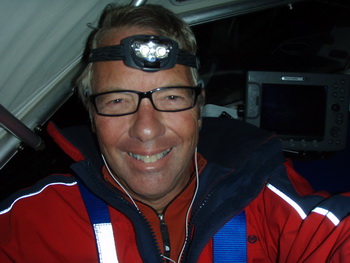
January 2009
Part One
| |
| HOME |
| About Tenaya |
| About Us |
| Latest Update |
| Logs from Current Year |
| Logs from Previous Years |
| Katie's View |
| Route Map |
| Links |
| Contact Us |
![]()
January 3, 2009
Before heading off across the Atlantic, again, on December 18, we stopped at the fishing harbor in Mindelo on Sao Vicente Island to fuel up.
The small place was packed with local fishing boats tied to the walls and one another. We jilled about for a few minutes until someone pointed to a place to dock snugly between a row of boats and a pile of rocks.
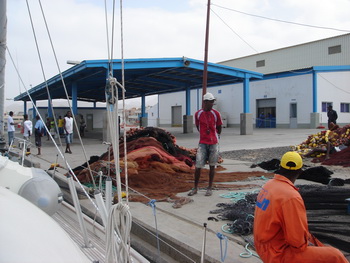
Fuel dock at Mindelo, Cape Verde Islands
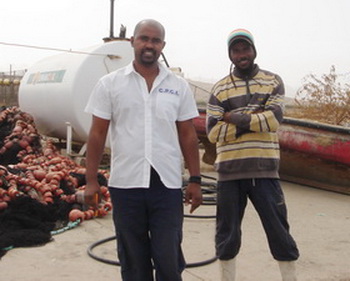
The guys at the fishing harbor were very nice and excited to talk about Obama
People began to trickle over to have a look at us and to help. The man on the right pumped our fuel and exclaimed "Obama, yeah!" when he saw our American flag, leading to little dances of joyful body motions. The guy on the left pointed to his skin and said "Your new president has skin the same color as mine" with a big smile. For the first time in many years we were proud while talking about our government.
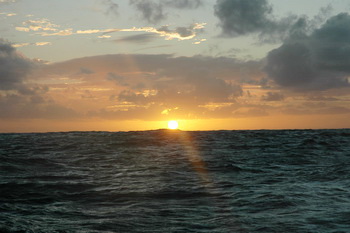
Sunset over the Atlantic
The weather was perfect to start our voyage. Wind was 15-20 kts. from the NE, waves were moderate (1.25-2.5 meters) and the temperature was warm (about 80 degrees). Tenaya sailed along nicely for a few days wing-and-wing.

Sailing along with reefed sails
Eventually the wind and waves increased and things got a bit more rolly in the rough (2.5-4 meter) sea. We found it was most comfortable sailing with the wind at about 150 degrees and the sheets fairly tight. We might have gone faster with the sheets eased but the jib flappered and the boom banged too much because of the rolling. We secured the boom by tightening the preventer and then pulling in the main, making it hold pretty steady. As the wind increased we reefed the main and jib. The in-mast furling allowing us to reef the main going downwind on either tack, a really nice thing when it's blowing a hoolie.
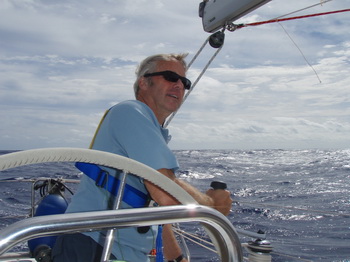
Jim tightening the main against the preventer
Life was simple during the crossing: watch, read, sleep, eat. Time was measured in four hour increments -four hours on watch, four off. Usually we slept during the off watch hours although that was our time to get weather info, send and receive messages, wash up and organize meals. As the waves became bigger the meals became more basic.
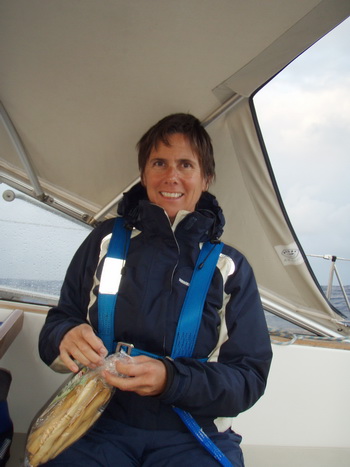
Lunch one rolly day consisted of breadsticks and olive tapenade from Italy. A delicious treat, actually.
![]()

The sea during a squall
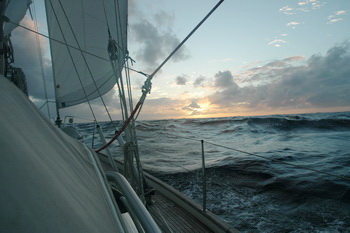
Waves starting to build
Squalls usually happened at night but our last couple of days were filled with them. We never knew until it hit whether a squall was bringing high winds or just a lot of rain. A few times the wind picked up so quickly that the windvane couldn't adjust and we rounded up into the wind. Shortening the main solved the problem.
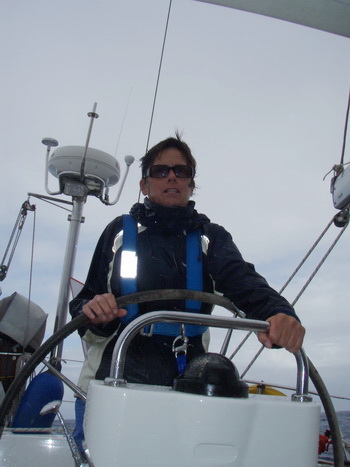
Katie hand steering during a windy squall

Squall on the radar
.

Sunrise over the Atlantic
The sunrises and sunsets were spectacular. Clear nights with little or no moon were magical with millions of stars shining brightly overhead.

With no moon it was pretty dark out there
Every morning we found flying fish on the deck. It is amazing the distance these little creatures cover in the air. Sometimes they fly in groups like a small flock of birds and other times they fly solo. One night I was startled by a flapping sound in the cockpit and shined my headlamp behind the pedestal to find a rather large flying fish bouncing and twisting on the sole. I flung him out unharmed, minus a few scales.
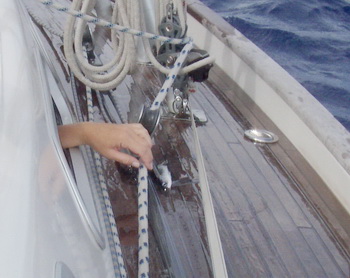
I opened the window to a fishy smell. Outside was a small flying fish.
We ticked off each hour on watch by doing a log entry recording the time, our position, log, speed over ground, wind speed and direction, course required and steered, sea state and weather. The time went by quickly enough as we read, exercised and stretched, listened to our iPods and just gazed out at the amazingly vast sea and sky.

Jim doing a log entry

Day watches aren't too tough in nice weather

Jim keeping in touch with family and friends
After 16 days and 2650 miles we reached Barbados. The greatest distance we traveled in 24 hours was 185 miles and our average speed was just over 6 kts. We consulted with Commander's Weather and downloaded grib files to choose our route, coming across at between 13 and 14 degrees Latitude.
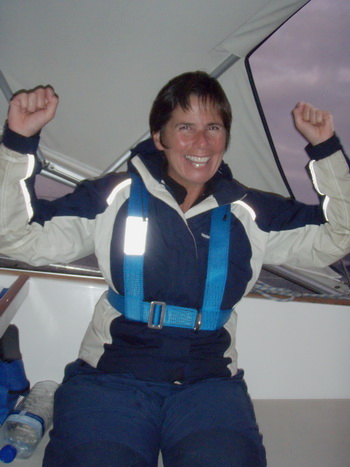
We made it!
Arriving just after sunset, we sailed around to the lee of the island and hove-to until dawn on January 3. Customs and Immigration were easy at Port St. Charles where we were able to buy fuel. Sailing 11 miles down the island brought us to Carlisle Bay, just outside the capital city of Bridgetown. Time to relax, swim, snorkel and explore.
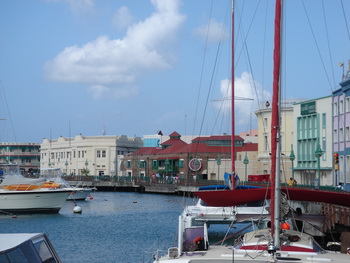
The Careenage at Bridgetown
We had a few small equipment failures and glitches along the way: 1) The roller furling broke. Jim jury-rigged it in the Cape Verdes but it continued to lose pieces. We kept it working with our precision line work. 2) At one point the electric winch for the starboard jib turned on by itself and rapidly tightened the sheet. Fortunately Jim was quick enough to stop it before the sail ripped. 3) The automatic bilge pump decided to pump continuously, even after the water was gone. 4) All the engine gauges stopped working. That one was easily fixed. So, nothing major. All in all we are very happy with how comfortable our HR 40 is and how well she performed during the crossing. She took care of us nicely.

What is left of our roller furling